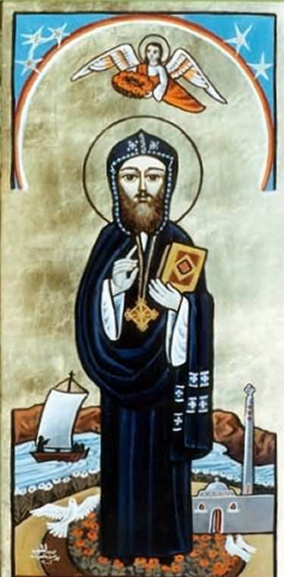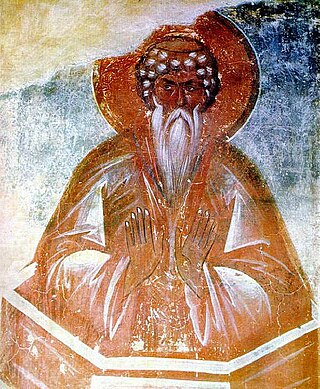
Gregory of Nazianzus, also known as Gregory the Theologian or Gregory Nazianzen, was a 4th-century Archbishop of Constantinople and theologian. He is widely considered the most accomplished rhetorical stylist of the patristic age. As a classically trained orator and philosopher, he infused Hellenism into the early church, establishing the paradigm of Byzantine theologians and church officials.

Pachomius, also known as Saint Pachomius the Great, is generally recognized as the founder of Christian cenobitic monasticism. Coptic churches celebrate his feast day on 9 May, and Eastern Orthodox and Roman Catholic churches mark his feast on 15 May or 28 May. In the Lutheran Church, he is remembered as a renewer of the church, along with his contemporary, Anthony of Egypt on 17 January.

Basil of Caesarea, also called Saint Basil the Great, was a bishop of Caesarea Mazaca in Cappadocia, Asia Minor. He was an influential theologian who supported the Nicene Creed and opposed the heresies of the early Christian church, fighting against both Arianism and the followers of Apollinaris of Laodicea. His ability to balance his theological convictions with his political connections made Basil a powerful advocate for the Nicene position.

Severus the Great of Antioch, also known as Severus of Gaza or the Crown of Syrians, was the Patriarch of Antioch, and head of the Syriac Orthodox Church, from 512 until his death in 538. He is venerated as a saint in the Oriental Orthodox Church, and his feast day is 8 February.

May 20 - Eastern Orthodox Church calendar - May 22

July 18 - Eastern Orthodox Church calendar - July 20

Saint Nicetas of Medikion or Nicetas the Confessor, who is commemorated on 3 April, was a monk who opposed Byzantine Iconoclasm.

January 29 - Eastern Orthodox liturgical calendar - January 31

February 9 - Eastern Orthodox liturgical calendar - February 11

·

Saint Simeon Stylites the Younger, also known as Simeon of the Admirable Mountain, is a saint in the Catholic Church and Eastern Orthodox Church.

Daniel the Stylite is a saint and stylite of the Eastern Orthodox, Roman Catholic and Eastern Catholic Churches. He is commemorated on 11 December according to the liturgical calendars of these churches.

Theodore Stratelates, also known as Theodore of Heraclea, was a martyr and Warrior Saint in the Eastern Orthodox, Catholic and Oriental Orthodox Churches.

Procopius of Scythopolis was a 4th century martyr who is venerated as a saint. He was a reader and exorcist in the church at Scythopolis; he also was famous as an ascetic and erudite theologian. Eusebius of Caesarea wrote of his martyrdom, which occurred during the persecution of Roman Emperor Diocletian, and stated that "he was born at Jerusalem, but had gone to live in Scythopolis, where he held three ecclesiastical offices. He was reader and interpreter in the Syriac language, and cured those possessed of evil spirits." Eusebius wrote that Procopius was sent with his companions from Scythopolis to Caesarea Maritima, where he was decapitated.

Venerable Luke the Stylite lived in Constantinople in the 10th century.
Saint Peter the Hermit of Galatia near Antioch, in Byzantine Syria, lived in the early fifth century AD.

Joannicius the Great was a Byzantine Christian saint, sage, theologian and prophet. Well known for his devoted asceticism and defense of icon veneration, Joannicius spent the majority of his life as a hermit on Mysian Olympus, near what is today Bursa, Turkey. Joannicius lived during the reign of Emperor Theophilos, a noted iconoclast, which contrasted with Joannicius's embrace of icon veneration. Icon veneration was later restored to the Byzantine Empire under the reign of Empress Theodora, a move that some devotees ascribe to Joannicius's influence and prophecies. Joannicius served in the Byzantine army in his early years before devoting his life to ascetic study and monastic contemplation. He is venerated with a feast day on November 4 in the Eastern Orthodox Church and Roman Catholic Church.

November 17 - Eastern Orthodox liturgical calendar - November 19

December 19 - Eastern Orthodox liturgical calendar - December 21

Paul of Xeropotamou was a Byzantine ascetic, lived between the 9th and the 10th century on Mount Athos, where he also restored and founded monasteries. He is commemorated in the Orthodox Church and his feast day is on 28 July.












